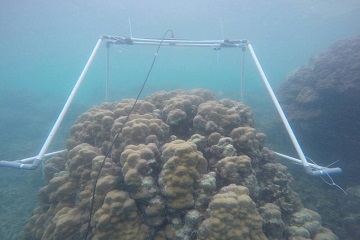A Group of IPB Students Utilized Acoustic Technology for the Characterization and Evaluation of Coral Reefs

Acoustics is the interdisciplinary science that deals with the study of all mechanical waves in gases, liquids, and solids including topics such as vibration, sound, ultrasound and infrasound. Acoustic technology utilizes the unique quality of sound in the ocean to essentially "see" in much the same way as vision is used on land. Acoustic technology is a technology that utilizes backscatter sound waves. This acoustic technology, commonly used to track submarines, has advanced tremendously in recent years and has become a primary tool for oceanographers, both for mapping the physical shape of the ocean floor and for tracking and counting marine animals of all sizes. Underwater detection using acoustics is currently being widely utilized as it is easy to use as well as avoiding various risks compared to other methods such as diving. So far coral detection was done with direct diving. Underwater diving is the practice of descending below the water's surface to conduct underwater activities.
The presence of a combination of several hazards simultaneously is common in diving, and the effect is generally increased risk to the diver, particularly where the occurrence of an incident due to one hazard triggers other hazards with a resulting cascade of incidents. Human factors are the physical or cognitive properties of individuals, or social behaviour which is specific to humans, and influence functioning of technological systems as well as human-environment equilibria. The safety of underwater diving operations can be improved by reducing the frequency of human error and the consequences when it does occur. Human error can be defined as an individual's deviation from acceptable or desirable practice which culminates in undesirable or unexpected results. But the risks faced are very large as the weather can change rapidly, experiencing hypothemia, decompression disease and others. Diving also requires special expertise and certification so that not many people can do it.
This is the reason why Danar Jovian Pratama, Haris Hadi Kusuma, Aulia Yogi Pangesti, Haris Aprianto Setiawan, and Tsabitah Shofiyana, a group of students of the Faculty of Fisheries and Marine Sciences of Bogor Agricultural University (FPIK IPB) designed a research program on the utilization acoustic technology for the characterization and evaluation coral reefs under the sea. The purpose of this research is to know the effectiveness of the use of single beam echosounder Simrad EK15 instrument to analyze and compare coral reef acoustic backflow value, as well as to provide alternative solution of reef characterization quickly and safely.
Acoustic signal detection using acoustic technology or commonly known as hydroacoustics can be utilized to detect the depth of a water body (bathymetry), as well as the presence or absence, abundance, distribution, size, and behavior of underwater plants and animals. The marine acoustic method is the process of detecting targets at sea by considering sound propagation, sound characteristics, environmental factors and target conditions.
Underwater detection in acoustic research can be divided into four types namely single beam, dual beam, split beam, and multi beam. Indonesia and several other countries use the single beam technique to detect underwater, as the single beam acoustic technique is relatively cheaper than other acoustic techniques. One of the underwater detectors using single beam acoustic technique is the scientific echosounder Simrak EK 15. This tool uses 200 kHz frequency and circular beam 31o.
Echoview is the world’s premier software package for hydroacoustic data processing, delivering powerful and flexible capabilities for water-column and bottom echosounder and sonar data processing. Echoview uses a fish-tracking technique called alpha-beta-tracking algorithm. While Simrad manufactures advanced sonars, echo sounders (fish finders) and catch monitor systems for the world's fishing fleet. Simrad EK15 uses single beam frequency for sounding. Scattering derived from seabed and sea level can be quantified from the value of scattering strength, while in monostatic sonar systems, the acoustic wave reflected back to the transmitter is called backscattering strength.
"The comparison between the reflection strength of the sound intensity with the intensity of the sound value received when it concerns the surface of the waters is called surface backscattering strength (SS). Scattering is the consequence of the combined processes of reflection, refraction and diffraction at surfaces marked by inhomogeneities, these may be external or internal to a scattering volume. Measurement of sea bottom surface backscattering strength by quantitative echo sounder. Bottom characterization was based on analysis of particle size distribution for bottom samples taken during the survey. The SS value increases with the increase of the mean diameter of the bottom particles. The SS decreased with increasing frequency. A mean backscattering strength and a standard deviation from the mcan were calculated for the ensemble of envelope data records, "said Danar. (Wied)



